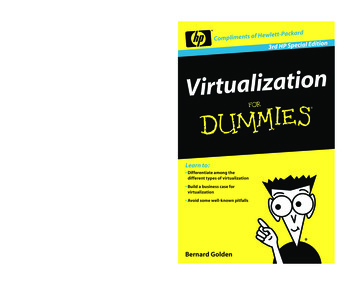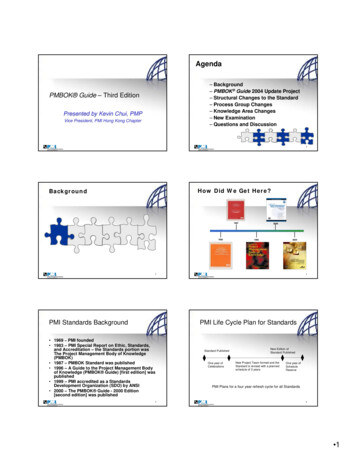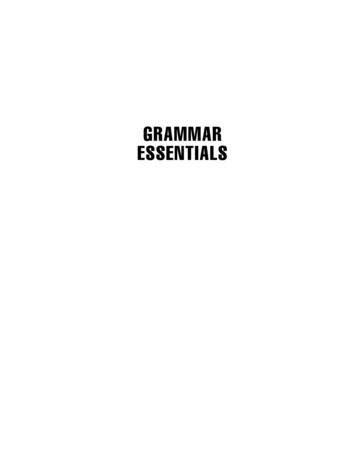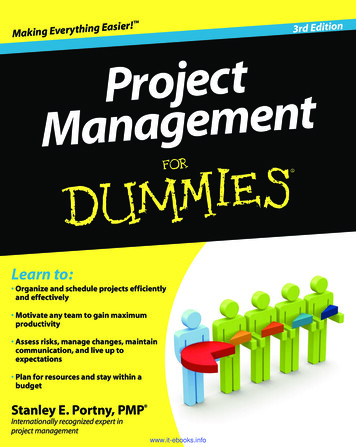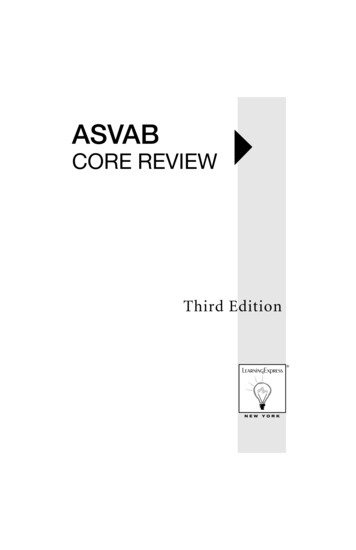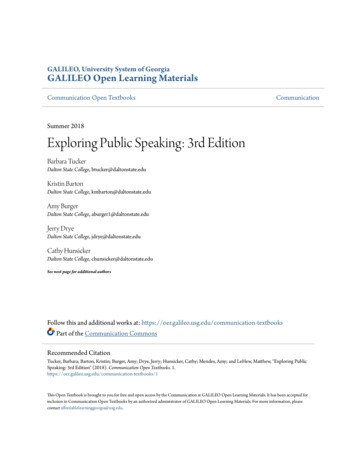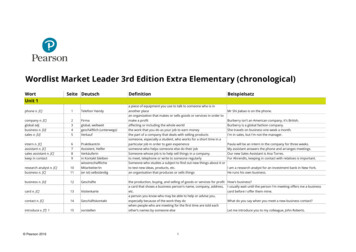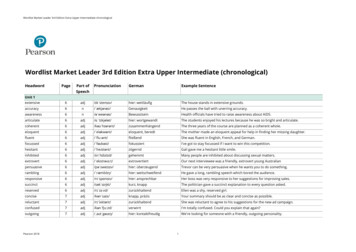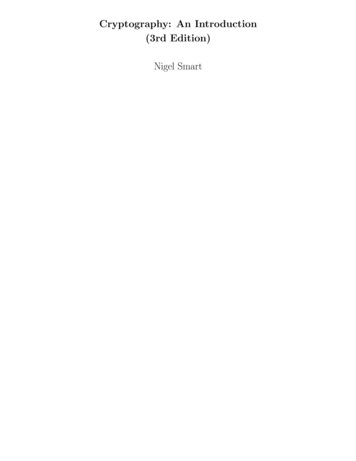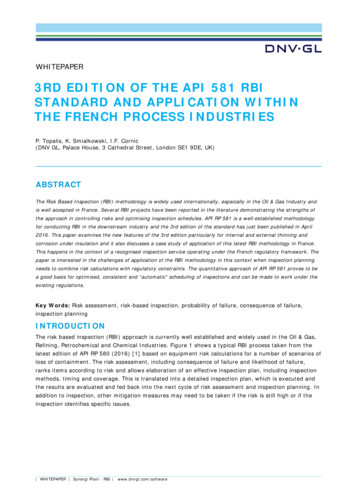
Transcription
WHITEPAPER3RD EDITION OF THE API 581 RBISTANDARD AND APPLICATION WITHINTHE FRENCH PROCESS INDUSTRIESP. Topalis, K. Smialkowski, I.F. Cornic(DNV GL, Palace House, 3 Cathedral Street, London SE1 9DE, UK)ABSTRACTThe Risk Based Inspection (RBI) methodology is widely used internationally, especially in the Oil & Gas Industry andis well accepted in France. Several RBI projects have been reported in the literature demonstrating the strengths ofthe approach in controlling risks and optimising inspection schedules. API RP 581 is a well-established methodologyfor conducting RBI in the downstream industry and the 3rd edition of the standard has just been published in April2016. This paper examines the new features of the 3rd edition particularly for internal and external thinning andcorrosion under insulation and it also discusses a case study of application of this latest RBI methodology in France.This happens in the context of a recognised inspection service operating under the French regulatory framework. Thepaper is interested in the challenges of application of the RBI methodology in this context when inspection planningneeds to combine risk calculations with regulatory constraints. The quantitative approach of API RP 581 proves to bea good basis for optimised, consistent and “automatic” scheduling of inspections and can be made to work under theexisting regulations.Key Words: Risk assessment, risk-based inspection, probability of failure, consequence of failure,inspection planningINTRODUCTIONThe risk based inspection (RBI) approach is currently well established and widely used in the Oil & Gas,Refining, Petrochemical and Chemical Industries. Figure 1 shows a typical RBI process taken from thelatest edition of API RP 580 (2016) [1] based on equipment risk calculations for a number of scenarios ofloss of containment. The risk assessment, including consequence of failure and likelihood of failure,ranks items according to risk and allows elaboration of an effective inspection plan, including inspectionmethods, timing and coverage. This is translated into a detailed inspection plan, which is executed andthe results are evaluated and fed back into the next cycle of risk assessment and inspection planning. Inaddition to inspection, other mitigation measures may need to be taken if the risk is still high or if theinspection identifies specific issues. WHITEPAPER Synergi Plant - RBI www.dnvgl.com/software
Figure 1: Typical Risk Based Inspection ProcessThe RBI application benefits are well known and they are summarized by API RP 580 (2016) [1]: RBI facilitates the development of optimised plans (inspection or mitigation plans) to managerisks on an equipment level RBI may provide an overall reduction in risk for the facilities and equipment assessed RBI provides an acceptance/understanding of the current risk RBI may identify equipment items that do not require inspection or some other form ofmitigation. Inspection & maintenance activities can be focused and more cost effective. Thisresults in a significant reduction in the amount of inspection data that is collected. RBI inspectionplans may also result in cost reductions.API RP 580 (2016) [1] documents, at a relatively high level, the essential elements of a “quality” RiskBased Inspection analysis in the hydrocarbon and chemical process industry and allows different types ofapproaches such as qualitative RBI or quantitative RBI. ASME PCC-3 2007 [5] is an alternative documentto API 580, possibly with more details in specific areas.A number of other documents have been developed which try to define RBI for specific sectors or forspecific geographical areas. A joint industry project produced DNV RP G101 ([8], 2010) which describesa specific RBI methodology for the upstream offshore topside sector. VGB (2012) [14] has published thedocument S-506, which includes a procedure for RBI of components of steam boiler installations andwater /steam high pressure pipes.A further development of RBI took place in Europe with the RIMAP European research project (20012004) [12] which included maintenance, in addition to in-service inspection, and extended themethodology to other industries: power, steel, offshore, petrochemical and chemical industries. Anoutcome of this work was the publication of CWA 15740:2008 [6]. The requirements of this agreementcan be achieved easily but it does not have the status of a European Norm. A follow-up to this is theRBIF-EN (2012) [11] RBI standardisation project initiated in 2012 and run by Working Group (WG) 12,under the CEN Technical Committee (TC) 319 dedicated to maintenance. The main objective of RBIF-ENproject is to support the development of a European Standard (EN) for RBI during the in-serviceactivities which are still not harmonised throughout the European Union.On the other hand the best known document which established the RBI methodology worldwide is API RP581. The 1st edition of the document API 581 (2000) [4] described the basis of a specific quantitative WHITEPAPER Synergi Plant - RBI www.dnvgl.com/softwarePage 2
RBI methodology with full details: data tables, algorithms, equations, models. The second edition of API581 (2008) [3] included significant additions in a number of areas such as pressure relief devices (PRD),heat exchanger tube bundles, aboveground storage tanks (AST) and Level-2 consequence calculations.The 3rd edition of API RP 581 (2016) [2] has just been published and it will be one of the main topics ofthis paper. The API 581 methodology focuses on RBI for the downstream sector, especially refineries butit can be applied to similar process industries such as offshore Oil & Gas or thermal power plants withsome extensions/ adjustments. P. Topalis et al (2015) [13] report a case study of application of API RP581 3rd edition to a coal-fired power plant in Malaysia. The basic API 581 approach was found to beappropriate but it was supplemented by additional damage mechanism models, a re-thinking of the plantasset hierarchy and an adjustment of the assessment workflow.This paper will first present some new features of the 3rd edition of API RP 581 and will then continuewith a case study of application of the methodology to a gas plant in France.API RP 581 THIRD EDITION NEW FEATURESThe single most significant new feature of the 3rd edition is the method of calculating probability offailure for the internal or external thinning damage mechanisms.Probability of failure for thinning damage mechanismsLoss of wall for a vessel or pipe can occur on the inside of the equipment or on the outside underinsulation or in the absence of insulation. According to the API RP 581 classification, there are 3mechanisms affected by this change: Internal Thinning External corrosion for ferritic components Corrosion under insulation for ferritic componentsIt is worth remembering the equation for calculating the probability of failure Pf (t) for an equipment itemand a given damage mechanism in the API 581 methodology:Pf (t) gff FMS Df (t)Where gff is the generic failure frequencyFMS is the management systems factorDf (t) is the damage factorAs the original intention of API 581 was to provide a workbook for easy hand calculations, the damagefactor was initially tabulated for a small number of parameters, particularly the Art parameter, which isthe ratio of wall loss over the initial thickness.Figure 2 shows the table that was included in the 1st and 2nd edition of API RP 581 for the calculation ofthe thinning damage factor. This was based on a structural reliability model, which uses a limit statefunction g Load – Resistance, supplemented by a Bayesian approach to account for the equipmentinspection history. “Smoothened” values had actually been used in the table to avoid some imperfectionsof the model but the process of producing the Art table was not very transparent. WHITEPAPER Synergi Plant - RBI www.dnvgl.com/softwarePage 3
Figure 2: Thinning damage factor as function of Art in the 1st and 2nd edition of API RP 581The perception in the industry was that the old Art table had a number of weaknesses: The table only considered Art and the past inspection history as input parameters, while otherparameters had been set to average values but these average values didn’t represent well allsituations. The table was not applicable to spherical/ semi-spherical equipment The process of producing the table values, including the smoothening of the model values wasnot documented and was difficult to defend. The Art approach didn’t reference the design minimum thickness and this created a clashbetween the RBI results and the minimum thickness analysis. The original Art approach was based on a generalised thinning failure mode and it was not clearhow this could be applied to localised thinning.Because of these perceived weakness the thinning factor calculation method was revised and the Arttables were replaced with a more rigorous calculation procedure, as shown in Figure 3, which makes useof strength ratios SRp and design minimum thickness. This procedure is now used for internal thinning(except tank bottoms), external corrosion and corrosion under insulation for ferritic components. Arttables are still used for tank bottoms and for SCC damage factors. WHITEPAPER Synergi Plant - RBI www.dnvgl.com/softwarePage 4
Figure 3: Thinning damage factor calculation procedure in API RP 581 3rd editionOther changesThe HTHA (High Temperature Hydrogen Attack) quantitative RBI model described in previous 1st and 2ndeditions of API 581 was based on previous versions of the API 941 and has been subject to criticism afterrecent accident in the refining industry. The accident investigation indicated that the old Nelson curvesfor carbon steel were not conservative enough. During preparation of the 3rd edition of API 581, API 941was still under revision and there was no sufficient time for preparation of an update of the quantitativeRBI method for HTHA in API RP 581.Therefore API 581 3rd edition describes a conservative screening approach for HTHA while it is left to theowner / operator to take the responsibility and put more details into the HTHA RBI approach. The latestedition of API 941 came out in February 2016 with updated HTHA carbon steel curves but this newinformation has not yet been included in API 581.There is a new appendix in API 581 with updated inspection effectiveness tables: tables of the variousinspection techniques (including coverage) and their effectiveness for each damage mechanism. Newtables now appear for heat exchanger tube bundle inspections.Smaller updates also appear in numerous other parts of the standard such as in the risk matrix definition,generic failure frequencies, the PRD model, the calculation of alkaline sour water corrosion rates etc.RISK BASED INSPECTION IMPLEMENTATIONThis paper describes the implementation of API RP 581 RBI 3rd edition approach in the Synergi Plant RBIOnshore software (DNV GL, 2016). In practice the RBI implementation is part of the integritymanagement of the plant. Figure 4 shows a typical integrity management cycle for a plant based on thePlan-Do-Check-Act (PDCA) approach and this is basically the cycle facilitated by the Synergi Plant WHITEPAPER Synergi Plant - RBI www.dnvgl.com/softwarePage 5
software. Based on equipment data and past inspection history, risk for each item is evaluated, includingconsequence of failure and likelihood of failure. This allows elaboration of an effective inspection program,including inspection methods, timing and coverage.Figure 4: Plan-Do-Check-Act (PDCA) Cycle in Integrity ManagementIn turn, this is translated into a detailed inspection plan, which is executed and the results are evaluatedwith the possibility of follow-up actions. The new inspection data are fed back into the next cycle of riskassessment and inspection planning. The risk assessment circle in Figure 4 is what is typicallyunderstood as RBI. WHITEPAPER Synergi Plant - RBI www.dnvgl.com/softwarePage 6
RiskRisk TargetPredicted RiskIncreaseFairly EffectiveHighly EffectiveTime to next inspectionStart dateRBI Datest1 TurnaroundPlan DateTimePlan periodFigure 5: Inspection planning based on quantitative risk criteriaFigure 5 shows the API RP 581 approach for determining inspection dates and inspection tasks /effectiveness based on the quantitative calculation of the component risk as function of time. One ormore inspection targets (e.g. maximum acceptable risk) must be set and the model algorithm identifiesa date when the risk intersects the target line. The method also suggests the required inspectioneffectiveness (typically the minimum acceptable effectiveness, which allows the risk value to be withinthe acceptable limits at the future evaluation date. This suggested effectiveness is then converted to aspecific inspection technique and coverage based on the API 581 inspection effectiveness tables.This approach can be used both for planning the inspection activities for the periodic turnaround /shutdown as well as for planning the on-stream inspections. Since many plant inspections are stillperformed during the shutdowns, this approach is typically appropriate for defining the scope ofinspections for the shutdown.CASE STUDY - RBI IMPLEMENTATION IN THE TIGF GAS PLANT INFRANCERBI is well accepted in France as a method to assess pressure equipment risks and plan inspectionsaccordingly and has been used in the Oil & Gas, chemical and petrochemical industry during the last 10years. On the other hand the regulatory framework in France for managing in-service inspections is quitespecific to the country and there are some constraints on inspection and requalification intervals whichneed to be respected. Overall the API RP 581 methodology is accepted in the country but it is veryinteresting to see a specific case study (TIGF gas plant) to understand how the methodology fits theFrench regulatory framework. WH
API RP 581 is a well-established methodology for conducting RBI in the downstream industry and the 3rd edition of the standard has just been published in April 2016. This paper examines the new features of the 3rd edition particularly for internal and external thinning and corrosion under insulation and it also discusses a case study of application of this latest RBI methodology in France .
![API Ballot: [Ballot ID] – API 510 & API 570, Deferrals, Rev05](/img/5/api510andapi570deferralsrev5.jpg)
